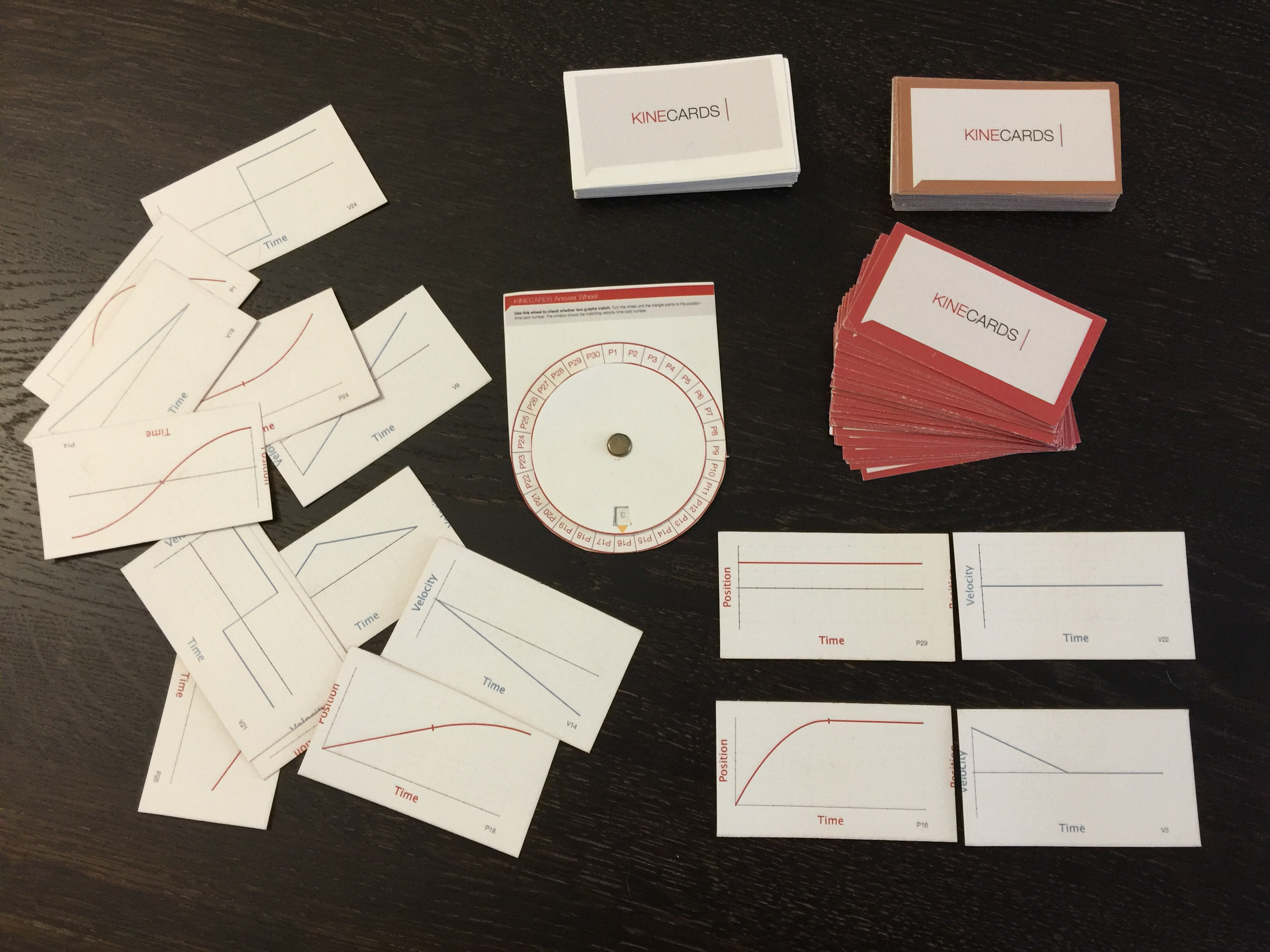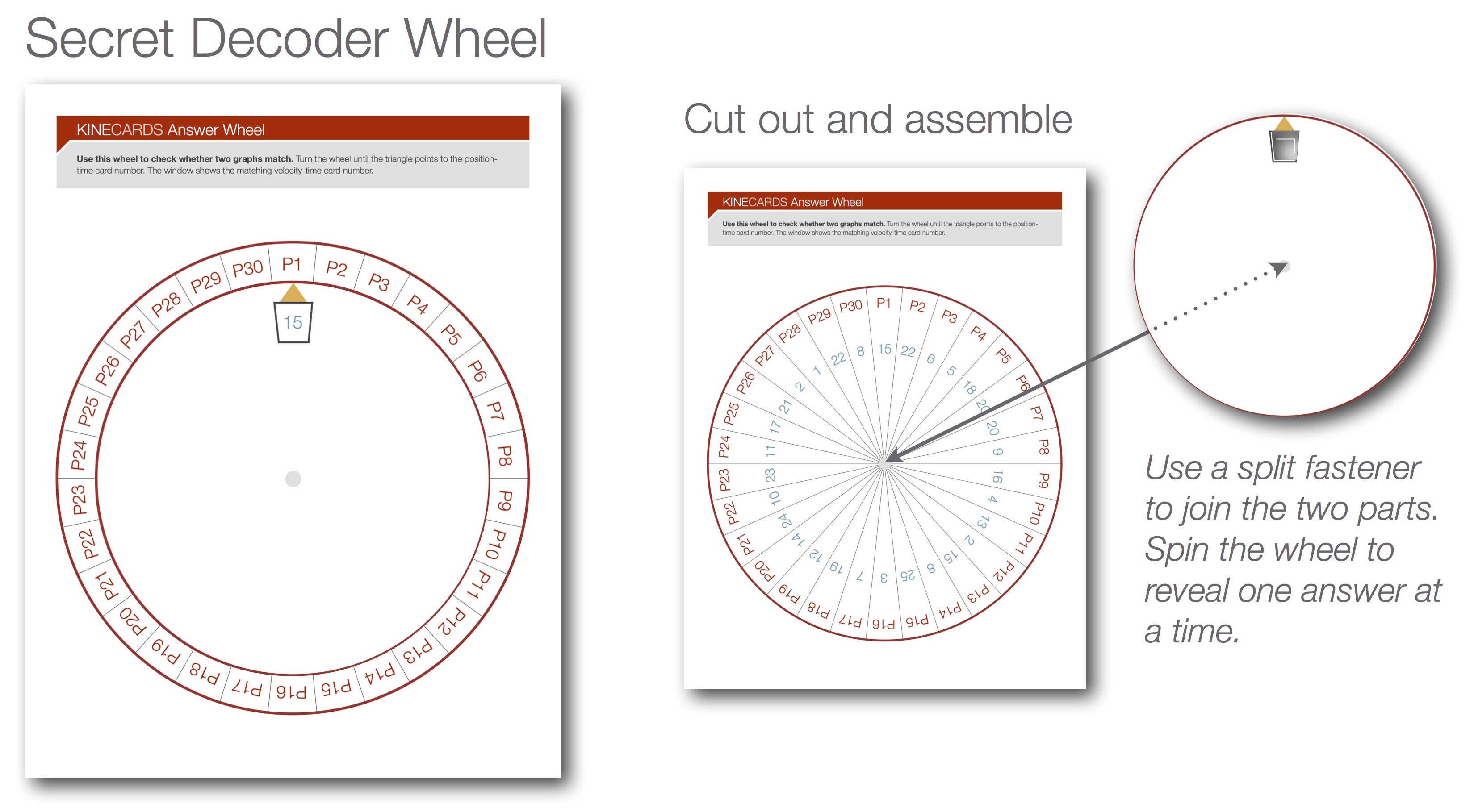September 30, 2021 Filed in:
ArticlesRobert Prior, ePublisher of OAPT Newsletter
science@robertprior.caMany of our students struggle with mastering the relationship between position-time graphs and velocity-time graphs. They may know that the velocity-time graph shows the slope of a position-time graph, or that the position-time graph shows the area under the velocity-time graph, but they have trouble telling if two graphs are related except by actually doing the calculations.
We all know that practice makes perfect, but drawing many graphs takes lots of time, and time is in short supply. This activity uses pre-drawn graphs so students spend time thinking rather than drawing.
 The Cards
The Cards
KineCards (pronounced kin-uh-cards) is a set of 60 cards: 30 position-time graphs and their corresponding velocity-time graphs. The simplest graphs show just a single type of motion, such as constant positive velocity. More complicated graphs combine two or three motions together, such as constant negative acceleration followed by constant positive velocity.

To enable checking a result without the teacher, there is a ‘secret decoder wheel’ that checks a single match at a time.
 The Workbook
The Workbook
One problem with the KineCards activity is that students have no record of it, so they have nothing to review later. The supplementary workbook contains all the graphs from the KineCards deck. Half the graphs are printed in the workbook, with blanks beside them for the corresponding graphs which are cut out of a separate sheet and glued in place.
Answers are given on the last page, so students can complete it and check their results without their teacher.
 The Quizzes
The Quizzes
KineCards is a matching activity, so a matching quiz is a good way to evaluate how much students have learned. The quiz package contains five quizzes of increasing difficulty, each with 12 graphs to match.
 Using KineCards in the Classroom
Using KineCards in the Classroom
My class is already seated in groups of 3-4 students who are used to working together; if necessary I move students around so no one is alone for the activity. Each group gets one set of cards.
I briefly explain the task: to sort the cards so that each position-time graph is matched with the corresponding velocity-time graph. Once they are finished they will get a secret decoder wheel to check their work, which I explain how to use as well.
After that it’s a race to see who will be the first to get a perfect result (i.e., no mistakes).
Once a group is finished I collect the cards and hand them each a copy of the workbook, to be worked on for the rest of the class. If necessary, completing the workbook is homework.
The secret decoder wheel turns out to be surprisingly popular with students. Every class I have at least one student who is intrigued by it, so I’ve begun designing other analogue devices to catch their interest.
The next day I start class with a quick matching quiz to see how much they learned. I usually give about 10 minutes for the quiz (or until everyone is finished, for a faster class). Then papers are passed to the group behind and marked as a class so we can discuss the answers; I collect the papers to record their marks and return them to the students after that (usually during the same period).
Where to Get KineCards
KineCards can be downloaded from my website:
http://science.robertprior.ca/physics-11/kinematics-11/index.htmlThere are three files available: the cards, the workbook, and the quizzes based on the cards. I may expand the quizzes package to contain more quizzes, if I have time.
Printing
The cards are sized to be printed on pre-punched business card stock. You can use regular card stock and cut the cards out by hand, but the pre-punched cards save a lot of time. Although only the card fronts need to be printed, the file includes card backs in eight different colours — which makes sorting out commingled sets a lot faster if your students mix them up!
https://www.staples.ca/products/41168-en-gartner-studios-business-card-3-12-x-2-white-paper-750-cardspackhttps://www.staples.ca/products/733350-en-staples-card-stock-8-12-x-11-white-250packThe secret decoder wheel should be printed on regular card stock, cut out, and attached with a split fastener.
https://www.staples.ca/products/11514-en-staples-brass-fasteners-1The cards can be printed in black-and-white, but work better in colour as there is a visual distinction between position-time and velocity-time graphs. The workbook and quizzes work in either colour or black-and-white.
Remote Learning
This activity is not well suited to remote learning, seeing as many students lack printers and will not turn on their cameras.
Tags: Kinematics, Motion, Pedagogy






